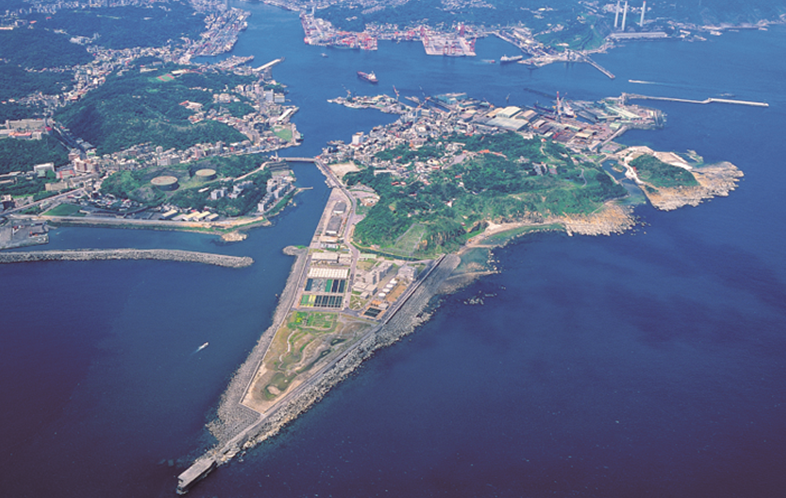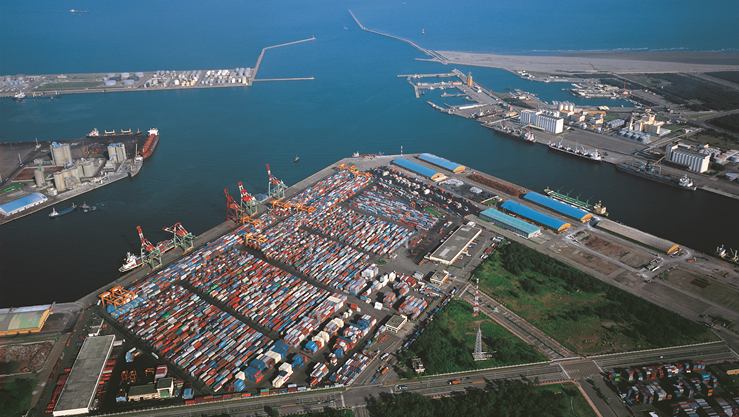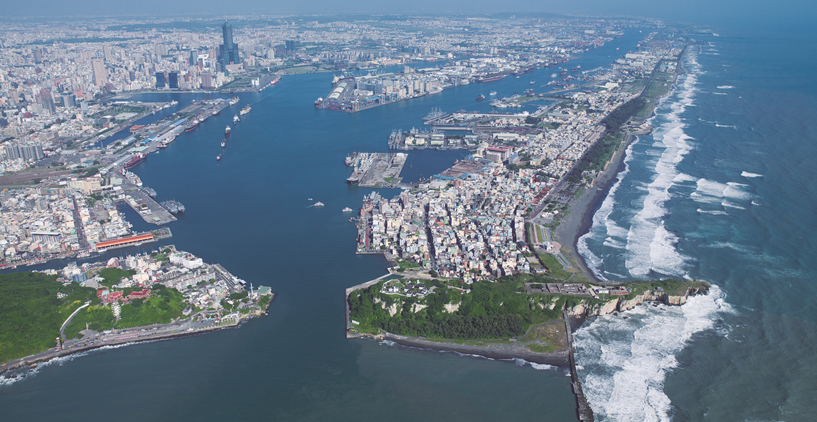1) The Taiwan International Ports Corporation (TIPC)
The Ministry of Transportation and Communications (MOTC) was formerly responsible for administering and supervising the nation's four Harbor Bureaus (Keelung, Taichung, Kaohsiung, and Hualien). However, bureaucratic hurdles impeded the ability of these Harbor Bureaus to take full advantage of business opportunities and respond effectively to business challenges. In order to improve efficiencies and enhance regional and global competitiveness, the MOTC in 2010~2011 drafted plans to divest from port operations, in line with current international trends. On March 1st, 2012, the Harbor Bureau system officially ended. The newly formed Taiwan International Ports Corporation (TIPC) took over the former port operation and management functions of the four Harbor Bureaus, while the new Maritime and Port Bureau, MOTC took over their former maritime / port policy and supervision functions.
TIPC is a national enterprise that is wholly owned by the MOTC and headed by a Board of Directors and a Board of Supervisors. TIPC administers the four subsidiary organizations of the Port of Keelung, Port of Taichung, Port of Kaohsiung, and Port of Hualien and manages all aspects of the business of these ports, their associated facilities, and their auxiliary ports. Business-oriented operations have improved the effectiveness and flexibility of port operations greatly and are fueling renewed port growth and expansion and stimulating local economic and industrial prosperity.
The modern economic importance of Mainland China and of other countries in the Asia Pacific Region makes Taiwan, at the nexus of trans-Pacific and Asia-Europe shipping routes, an ideal hub for trade and commerce. Located conveniently in northern, central, southern, and eastern Taiwan, TIPC ports are backed by modern port infrastructures, surrounded by world-class industries, and connected directly into efficient national road and rail networks.
2) Port of Keelung The resemblance of a nearby mountain to the shape of a traditional bamboo chicken hutch (jee-long) is the reputed origin of the modern-day name of Keelung City. Keelung was a focus of Spanish activity on the island during the 17th century when Spain occupied strongholds across northern Taiwan, sponsored expeditions inland, and established a short-lived but bustling outpost at the head of Keelung Bay. Western traders reestablished a presence at Keelung Harbor in the waning years of the Qing Dynasty and, in 1863, the port was formally opened to international trade as an auxiliary port of Danshui (Tamsui). The first efforts to modernize the port came in 1886 under the direction of then-Qing governor Liu Mingchuan, who appointed the tycoon Lin Weiyuan to handle related planning work. Governor Liu further ordered the island's nascent railway to be extended all the way to Keelung Harbor. However, modernization efforts at the port largely ground to a halt after the governor stepped down. Of the various projects, only one, an integrated sea-to-land wharf, was completed.
During the Japanese Colonial Period (1895-1945), Keelung was developed as a major terminal of trade, transportation, and communications between Taiwan and the Japanese home islands. Colonial administrators implemented major improvements and expansions at the port over 5 phases between 1899 and 1944, although work on the fifth phase remained unfinished due to the Second World War.
Through much of the first half of the 20th century, Keelung's colonial port authority cleared the inner harbor area of coral reefs and, in the outer harbor area, constructed large-scale ship works, naval wharves, a fishing harbor and other facilities. By mid-century, Keelung Port had a comprehensive wharf and warehouse infrastructure that was well integrated into the harbor railway network. The warehouse buildings adjacent to Port of Keelung West Wharves No. 2 and 3 date from this period. This five-phase development program not only set the foundations for future port growth but also made Keelung Taiwan's largest international port well into the 1970s. Throughout the Japanese Colonial Period, the Port of Keelung was unique in being administered by the military rather than a civilian agency. Until 1945, Keelung was one of many ports throughout the Japanese Empire that was administered directly by the Imperial Japanese Navy.
The Taipei Prefectural Harbor Office (Taihoku-shu Komubu), supervised by the Prefectural Bureau of Transportation's Maritime Affairs Office (Sotokufu Kotsukyoku, Kaimubu), was responsible for day-to-day port operations. To meet the needs of wartime, the colonial authorities in 1943 unified all port administration under a new Keelung Harbor Office that reported directly to the Government-General (Sotokufu).
The end of the war in 1945 signaled the end of Japanese sovereignty in Taiwan and the start of Chinese rule as part of the Republic of China (ROC). The ROC retained colonial-era Harbor Office mechanisms and made the Port of Keelung a provincial-level enterprise administered first by the Taiwan Provincial Administrative Executive Office (TPAEO) and then subsequently by the Taiwan Provincial Communications Department. After the dissolution of the Taiwan Provincial Government in 1998, Taiwan's 3 Harbor Bureaus (including Keelung) were subordinated to the ROC Ministry of Transportation and Communications (MOTC).

3) Port of Taichung
In 1938, the Taiwan Government-General (Sotokufu) announced plans to significantly expand Wuqi Harbor in order to both support central Taiwan industries and better support Japan's expansionist ambitions in Southeast Asia. Once finished, the new harbor facilities would help shoulder the island's expanding shipping needs and bridge the significant distance between Taiwan's two main ports at Keelung (Kirun) and Kaohsiung (Takao). Wuqi was to be a dual-purpose fishing and industrial harbor. The harbor was renamed Niitaka Port in 1939 to honor Taiwan's tallest mountain, Yushan (Niitaka in Japanese), and a groundbreaking ceremony was held on September 25th. The project was expanded in 1941 with plans to incorporate the new port and its surrounding communities into a new municipality - Niitaka City. However, wartime funding shortages and U.S. bombing raids led authorities to suspend all work.
After the Republic of China assumed control of Taiwan in 1945, Niitaka Port, soon renamed the Port of Taichung, enjoyed a period of prosperity that lasted long enough for the government to consider re-designating neighboring Wuqi City as a provincial-level municipality. However, the Chinese Civil War and the retreat of the Nationalist Government to Taiwan halted Cross-Strait shipping and sank the Port of Taichung's immediate prospects for prosperity. Significant expansion of the port would wait until ROC Premier Chiang Ching-kuo (CCK) included the Port of Taichung as part of the national “Ten Major Construction Projects” program in the 1970s.
Taiwan's export-driven “economic miracle”, which began in the 1960s and lasted well into the 1990s, taxed severely the cargo-handling capacities of the ports of Keelung and Kaohsiung. The government thus took the decision to develop the Port of Taichung in order to relieve the pressure on Taiwan's two main ports, give industries in central Taiwan more convenient access to international markets, and improve the distributions of economic opportunity and population. Expansion plans called for the development of a multifunctional port supporting the needs of the trade / commerce, manufacturing, and fishing industries. The newly minted Port of Taichung officially opened for business on October 31st, 1973.

4) Port of Kaohsiung
The area that is now the Port of Kaohsiung was initially part of the homeland of the indigenous Makatao tribe. The Dutch East India Company (Vereenigde Oost Indische Compagnie or VOC) first set up trading operations on Taiwan in 1624 at Dayuan (today's Anping District in Tainan City). In 1662, the Ming loyalist Koxinga (Zheng Chenggong) defeated the VOC and established his family's reign over the settled western and northern areas of the island. Han Chinese settler Hsu Ah-hua and others settled Qihou (today part of Qijin District, Kaohsiung City) in 1673, and, by 1691, the area had already grown into a bustling coastal village.
Takow Harbor (today's Port of Kaohsiung) began formal operations as a commercial port in 1863, with a government customs office opening the following year in 1864. The imperial Qing government in China ceded both Taiwan and the Penghu Archipelago to Japan at the end of the First Sino-Japanese War in 1895. As an aspiring colonial power, Japan invested heavily in developing the economic potentials of its new possession. Colonial authorities promoted the production of rice, sugar, and other commodities, in part to supply domestic Japanese demand and in part to advance political, economic, and military unification with the Japanese home islands. To grease the wheels of this unification, colonial administrators sponsored major infrastructure initiatives that greatly expanded the island's rail and roadway networks and gradually turned the island's two main harbors at Keelung and Kaohsiung into impressively modern commercial ports.
When first opened in the mid-19th century, Kaohsiung (then known as Takao) quickly became an entrepôt for trade between Taiwan and the outside world. Merchants from the U.K., France, and Germany flocked to Takao to establish hongs (merchant offices) and warehouses, fueling a local economic boom. The Qing government established a Customs Office at Cihou near the entrance to Takao (Kaohsiung) Harbor in 1863, appointing an Englishman as the harbor's first Customs official. This was the start of Port of Kaohsiung's steady transformation from a fishing port into a commercial port of call and then to one of the world's largest and most important commercial ports.
In 1904, the colonial harbor authority laid the foundations for coastal warehouses, removed sandbars from the harbor entrance, and created nearly 140,000m2 of reclaimed land for use by the harbor railway. A public dredging agency, created in April 1905, initiated the second phase of harbor development, launching a yearlong survey of the port's topography, geology, water depths, tides, weather, and surrounding seacoast. Port development plans were finalized in 1906, with implementation to be carried out in three phases. The first phase (1908 - 1912) deepened the entrance and navigation channels to admit vessels up to 3,000MT and gave the port a total of 7 wharves and 4 mooring buoys. The second phase (completed in 1937) opened the port to 8m draught / 8,000MT vessels, constructed 19 one-story and 6 two-story warehouse buildings, and increased annual cargo handling capacity to 1.4 million tons. Phase-two improvements to the port further stimulated industrial growth in the region in sectors including oil refining; aluminum, cement, and alkali manufacturing; and shipbuilding.
Allied bombing during the Second World War devastated Takao (Kaohsiung) Harbor, its facilities, and surrounding infrastructures. Officials sank five large ships at the harbor entrance to slow the anticipated (but unrealized) Allied invasion of southern Taiwan. Even before the end of the war, the port had been rendered unusable.
When transferred to the Republic of China (ROC) in 1945, the Port of Kaohsiung was a wasteland of sunken ships and rubble. In December of that year, the ROC government created the Kaohsiung Harbor Bureau to administer the port and began clearing harbor channels of debris. A 12-year expansion program was launched in 1959 and, by 1980, the Port of Kaohsiung had the new Zhongdao (Chungtao) Commercial Port area with its 27 deep-water wharves and 2 shallow-draught wharves as well as the adjacent Kaohsiung Export Processing Zone, Qianzhen (Cianjhen) Fishing Harbor, Linhai Industrial Park, China Steel works, China Shipbuilding works, and the 1st through 4th Container Terminals. The port opened the Second Harbor Entrance in 1975 and finished the cross-harbor traffic tunnel in 1984. The 5th Container Terminal opened for business in 1989.

5) Port of Hualien
Systematic Han Chinese settlement of Taiwan's East Coast started around 1812 with the arrival of homesteaders from Yilan. They first settled along a bay known as Huilan that had been shaped by time and waves into a natural anchorage for coastal boats.
In 1931, the completion of a cliff-side roadway connecting Suao to Karenko (the colonial-era name of Hualien) greatly enhanced communications between northern Taiwan and Taiwan's long-isolated East Coast. However, this narrow road (the predecessor of today's Suhua Highway) did little to improve the flow of commerce. Recognizing the need to greatly improve the flow of commerce between the East Coast and the rest of the island, Taiwan's colonial Government-General (Sotokufu) invested 7.42 million yen over 8 years to upgrade the infrastructure at Hualien's Meilun Harbor. The 3 new wharves completed in 1939 could accommodate ships up to 3,000MT. The completion of East Coast hydroelectric works in 1940 further inspired plans to develop various heavy industries around the port, making further expansion of the harbor a priority. Although plans to invest 5 million yen to complete Phase-2 expansion by 1944 were made, they were shelved permanently by the financial strains of war.
After the war, the ROC government spent a decade repairing wartime damage to the port, with handled cargo volumes recovering steadily. A new Phase 1 expansion of the Port of Hualien (April 1959 - October 1961) increased annual cargo handling capacity to 500,000 tons. National export-oriented growth policies led the government to designate the Port of Hualien as an international commercial port in September 1962, helping grow exports through Hualien and bringing new economic opportunity to the East Coast. Steadily rising cargo volumes and vessel calls led to the launch of Phase 2 (1969 - 1973) and Phase 3 (1974 - 1977) expansion programs. In particular, the eight new wharves opened in 1977 greatly eased congestion. Phase 4 expansion (1979 - 1991) further opened the Port of Hualien to 30~40,000MT vessels and added new facilities that were critical to supporting regional industries.